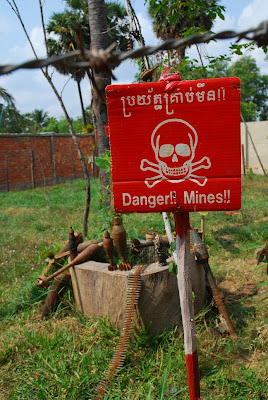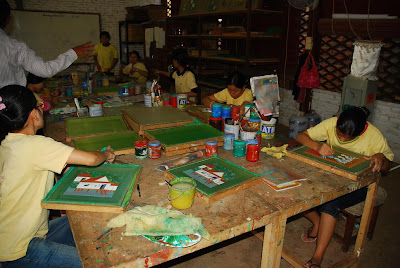Siem Reap is primarily known as the gateway to the Angkor temples. Over the past five years, the gateway has exploded to accomodate more than two million yearly visitors to the temples. Each available plot of land is turning into a hotel or restaurant. Tuk-tuk drivers get a new club member almost daily. How did all this get started? The government stabilized and opened its borders to tourism. They put a priority on demining the Angkor area which was heavily mined during the Khmer Rouge rule.
Aki Ra was very young when he was brought into the child camps of the Khmer Rouge. They trained him how to fire a rifle and how to place and arm landmines. He spent decades fighting in Cambodia's wars. When the Khmer Rouge finally disintegrated, he recieved demining training from a U.N. group. Since then, he's spent all of his years demining Cambodian land of the mines he helped place. Aki Ra charges $5 to $10 to defuse a mine and it takes him about an hour. In contrast, the international organizations cost an estimated $5,000, take a few days, and because they explode instead of defuse, areas must be evacuated. Once the mine is defused, Aki Ra doesn't clear all of the metals; he just removes the danger to make the land usable. International organizations use a metal detector to get everything cleared. However, if it takes $5,000 and days to demine one mine, when will Cambodia be mine-free? Aki Ra has defused more than 20,000 mines. Over the years, he saved the defused mines to start a museum. It became a very popular tourist attraction in Siem Reap and soon, the government gave him trouble. He was forced to close down so a prominant government official could start his own museum. Aki Ra purchased new land and opened a new Cambodian Landmine Museum about 20 km outside of Siem Reap; the government museum has been a failure in comparison. Through funds from international agencies, the museum, and CLMMRF (Cambodian LandMine Museum Relief Fund), he's created accomodations and a school for young landmine victims. The museum is on the same grounds as the victims' residence and school. The museum contains recent Cambodian history, stories of Aki Ra's demining projects, and of course, defused mines. Here's the official museum story.
The museum contains a replica of a demarked mine field in Cambodia.
There is still a lot of work to do; on our way to the museum, we saw two active mines just kilometers from the museum which have yet to be cleared.
Needless to say, Aki Ra has inspired numerous documentaries, news articles, and radio shows.
Now that mines are fewer, tourists are flocking to Siem Reap. Artisans d' Angkor is taking advantage by offering beautiful, handmade local products. They offer high-end silk products, modern antiques, and painted murals and best of all, these products are made by disadvantaged Cambodian youth. The company identifies a disadvantaged person, and if they desire, the person is trained in the Khmer arts of silk weaving, wood/stone carving, or painting. They have two workshops that can be visited by tourists. In Siem Reap, they have their painting workshop where a number of young, deaf females were creating Khmer murals.
They also have the stone and wood carving workshops where small handheld figurines to monstrous lawn decorations are produced.
About 15 kilometers outside the city is the silk farm. This is where they produce and weave beautiful silk products. The fields were full of mulberry bushes. The process begins by feeding the mulberry leaves to the silk worm.
The worm forms a yellow cocoon around itself as it mutates into a moth; this cocoon is where the silk comes from. The cocoon has two sections, a tightly wound thread which surrounds the mutating worm and a loosely wound thread that surrounds the cocoon and worm. Our guide told us the entire cocoon is one single, fine thread. To make it into a silk thread, they put multiple cocoons into hot water. The hot water helps to melt the glue holding the cocoon together and it also kills the worm. They grab strands from each of the cocoons and spin them together to make a silk thread.
The outer loosely wound thread of the cocoon is removed first and used to make raw silk. The inner tightly wound thread of the cocoon is removed afterwards to become fine silk. From there, the yellow silk thread is taken to dyeing buckets for color.
In a step we didn't completely understand, the thread is spun on these wheels to strengthen it.
Finally, the thread is brought to the loom to be woven into fabric. In this photo, the artisan is weaving raw silk.
As with any of these tours, they drop you off in the gift shop. This shop has some of the most beautiful silk items that we have seen in Southeast Asia (see the online catalogue). Unfortunately, the prices are triple that of other shops in the region. Laura was able to hold back at the giftshop, but that didn't mean we didn't go elsewhere. We all know how these tours end.
The restaurant business is booming in Siem Reap, and it's difficult to find Cambodian people trained in hospitality. This fact has forced some restaurants to take it upon themselves to train chefs, hosts, and waiters. Butterfly Garden takes disadvantaged people from nearby villages and trains them in a restaurant trade at their restaurant. Each week, they also have a traditional music and dance performance and restaurant proceeds go towards supporting the Khmer traditional arts. Finally, Butterfly Garden has earned its name. The dining area is engulfed by a net to hold hundreds of butterflies. The restaurant pays rural village children to deliver butterflies to them; the money for the butterflies is used so they can go to school. The dining experience is unique as butterflies flutter about everywhere.
Some got a bit too personal.
Siem Reap has become a center for "Dining/Shopping for a cause". The ones mentioned above are just a few of the many. We travel to Cambodia's capital city, Phnom Penh, next.
Now, a break from the travel blog to discuss Laura's silk purchasing. After visiting Artisans d'Angkor, Laura and I went in search of the best silk deals we could find. From store to store, the average price was $10/meter for fine silk and $12/meter for raw silk. We could bargain down to $7/meter and $9/meter correspondingly. As we discussed which store to purchase from, we entered the market where tens of vendors display souvenirs. We have been to hundreds of these throughout our trip, so we ignored the "Buy something, please" pleas of the market vendors. Then, we noticed a vendor who had a glass cabinet full of fine and raw silk. Her silk collection was more extensive than any store we had previously entered. She had large rolls of raw silk and four meter cuts of fine silk. More importantly, she had every color in the rainbow. We bargained with her and arrived at $5/meter for fine silk and $6/meter for raw silk. What a bargain! For the first time on our trip, Laura went on a shopping spree!
The following day, we returned to the market to visit our favorite vendor. Until seeing her shop, we hadn't recognized the 4-meter rolls of fine silk. As we entered the market, we began to notice that all the vendors were selling these fine silk rolls, even the same colors we had purchased the day before. Surely, nobody would be selling for less than we had purchased, but it can't hurt to ask.
"How much for the fine silk?"
"Six dollars." Ahh, $6/meter. Not a bad starting price. Perhaps I could talk her down to $4/meter.
"How long is it?"
"Four meters."
Because it hadn't yet been specified, I decided to see if I could get the entire roll for the price given. "Six dollars for the entire 4-meter roll?"
"Yes."
Laura's jaw dropped. Her eyes popped. Her eyebrows ruffled. It was the face of somebody that had been bamboozled! I clarified the coversation and ended up getting another eight meters for $10. At a quarter of the price, the silk was the same colors and quality as Laura had purchased the day before. Her shock turned to anger and it wasn't until after a good night's sleep that we had a conversation about anything else.
















1 comment:
Thank you for your wonderful story and Aki Ra and our children at the Land mine Museum. We are really excited you were able to see the wonderful work being accomplished!
The children have become the focal point of our work in Cambodia, I'm sure you know why! they are beyond amazing!
Enjoy the rest of your travels.
Asad Rahman
www.projectenlighten.org
P.S. Way to much snow here in California, you are not missing a thing!
Post a Comment